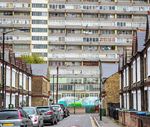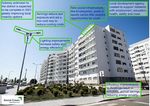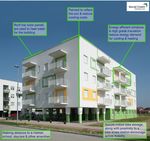Under One Roof: Solving Society's Most Pressing Challenges through Housing - 1 M ERDF - Interreg Europe
←
→
Page content transcription
If your browser does not render page correctly, please read the page content below
Under One Roof:
Solving Society’s
Most Pressing
Challenges
through Housing
Mitchell Reardon, Johannes Lidmo, Ryan Weber
1M Apr 2016
ERDF March 2021
Low-carbon
econom yStudents marching in the streets to demand climate action.
Vulnerable citizens facing energy poverty, gentrification and
unstable housing situations. A loneliness epidemic.
C
limate change, inequality & social isolation are heating and cooling systems, residents relied on highly
among the biggest challenges of our time, and inefficient remedies such as portable fans and electric
they have more in common than may first meet heaters. A series of upgrades between 2009 and
the eye. Each is a global challenge. Each requires local 2014 boosted livability and residents pride of place,
action as part of the solution. And with all three issues, while also including efficiency interventions—such
society’s most vulnerable residents risk facing the most as rebuilding and retrofitting homes with insulation,
negative impacts. double glazed windows, and efficient HVAC systems.
High-quality, resource-efficient housing—and the The project succeeded in reducing the neighbourhood’s
planning policy that enables it—can help address all environmental footprint and also in “returning the
three. dignity and identity to the neighbourhood by reducing
For the past three years, Interreg Social Green the social housing stigma.”
partners—based in Spain, Portugal, Croatia, This is only one good practice identified through the
Estonia, Sweden and Romania—have developed an Social Green projects, which entails working closely
understanding of the relationships between these with residents, developers and local housing providers
challenges, and have been collaborating on solutions by for appropriate responses and solutions. The Social
building and renovating resource-efficient social housing. Green partners’ work goes beyond specific interventions
One example is a neighbourhood in Portugal’s themselves, to highlighting good practices in building
Region Norte. As the Social Green good practice and policy and developing strategies for the sustained
describes, the Rainha D. Leonor neighbourhood was development of energy-efficient social housing in
a 60-year-old neighbourhood in “desperate need” of their regions. Their work providing green, affordable
renovation—so much so that it risked being demolished and comfortable housing for all residents is the very
completely. Because homes and buildings lacked definition of thinking globally and acting locally.
Barriers to progress
Realizing these ambitions isn’t easy. There are numerous particularly in terms of the quality of construction and
barriers that need to be navigated. By visiting each design of units and buildings.
partner region to inquire about issues and good A lack of common areas and comfortable spaces
practices, the Social Green team heard a common diminishes opportunities for social connection. For some
pattern of challenges from participants. residents, this contributed to a sense of loneliness,
Partners often don’t know how to access available and for others, it reduced their willingness to explore
funding. In the face of complex bureaucracies—and the opportunities for energy-efficient building renovations. ‘
need to meet evaluation criteria that seemingly change At a broader scale, all partners agreed that a lack
from one programme to the next—pathways to funds of comparable data and the absence of an EU-wide
are murky and unclear. definition for social housing—obscured the ability to
From a European policy perspective, a key barrier here develop European or regional understandings of the
is the fragmented nature of the funding landscape, and state of social housing. A number of partners lamented
the many smaller-scale investments that are required the limited attention given to resource-efficient social
for demand-side projects such as retrofitting individual housing in rural areas. Given that more than half of
apartment buildings. Europe’s population lives in rural regions and small or
A related issue is the inflexible nature of public funds medium-sized towns, the potential for improvements is
allocated for social housing retrofits, which limits the significant. The emergence of the gilets jaunes from rural
uses to which they can be put. and small towns in France adds important equity and
Many partners felt that this inflexibility limited political considerations to this complex series of issues.
the benefits—both real and perceived—for residents, Undoubtedly, many challenges exist. But so do solutions.Overcoming fragmented funding: KredEx in Estonia
The fact that the EU values energy-efficient housing is an energy focus and support resident comfort as well.
underscored by the array of funds available for retrofits To engage and educate potential beneficiaries, KredEx
and new builds. However, the piecemeal approach that offers free consultation to resident associations. After
many local authorities must use to cobble together slow initial uptake, the program has flourished. Nearly
investment for seemingly simple projects like individual 500 applications for the combined grant and loan
building retrofits remains a critical barrier. Numerous have been submitted, with more than 200 renovation
Social Green partners highlighted this issue; one partner projects, totaling 27,000 units now complete across
had a solution. Estonia.
The Tartu Regional Energy Agency (TREA) highlighted The nature of the program’s success is evident when
the KredEx Fund, an innovative renovation grant offered visiting an improved building. At Sõpruse 202 in Tallinn,
to resident associations in buildings across Estonia. Estonia, residents secured combined financing to reduce
Through the KredEx Fund, resident associations receive energy consumption in the building from 150 KwH/m2 to
funding that covers 15% to 40% of renovation costs. The 62 KwH/m2 at a cost increase of only 0.03€ per square
remaining funds are available through preferential loans metre. Once the loan is repaid, residents’ heating costs
offered by national banks. are expected to drop by about 60%.
These loans, which are offered directly to the resident Through smart financing and sustained engagement,
associations, are paid back through the energy cost KredEx demonstrates how residents and local
savings achieved through the renovations. To secure a authorities can access straightforward funding that
grant, resident associations must commit to improve improves quality of life without imposing a heavy cost
building energy performance to EPC level “C”, which in burden on residents. Estonia’s example demonstrates
Estonia tends to result in 50% to 70% energy savings for a way to achieve a triple win for society— combatting
most multi-unit buildings. climate change, addressing inequality and building
Importantly, improvements are intended to go beyond collaboration and trust among residents.
Site size: 10,000 m2
Söpruse 202 Number of units: 162
Tallinn, Estonia Unit size: 1-5 rooms
An ambitious deep renovation of an Eastern Bloc apartment com- Energy use: 62 kWh/m2
plex, coupled with Kred Ex, an innovative national financing policy Total Cost: 2 052 000 €
demonstrates that major energy efficiency improvements can be Transferrable renovation strategy
achieved without burdening residents with significant rent increases. KredEx: Innovative grant & soft loan modelFlexible funding success: Vila D’Este
Closely connected to the challenges of accessing The potential impacts of combining social and
investment is limited flexibility in how funds are resource efficiency upgrades were well illustrated in
used. The comprehensive infrastructure and capacity the Vila D’Este project. Built in the 1980s, a series of
required to finance projects costing millions of Euro social issues had emerged in this development, while
may be prohibitive for some authorities. In such cases, building quality had begun to deteriorate. This created
local governments and housing providers can look to an opportunity to secure funding for renovations to
Portugal’s Region Norte. improve energy efficiency; however, solely focusing on
Residents of Region Norte—low-income residents in energy would have generated community opposition.
particular—tend to face an array of social challenges and Instead, along with greater efficiency, the project
lack of community amenities, which are often viewed as promised improved public spaces, a community
more pressing needs than improved energy efficiency. swimming pool and a new kindergarten. By combining
Consequently, there are limited incentives for social social and climatic goals, the local authority was able
housing residents or authorities to pursue renovation to boost energy efficiency in 2,000-plus units by an
funds that focus exclusively on energy efficiency. average of 40%.
To address this, while developing their Regional More importantly from residents’ viewpoint, these
Operational Programme (ROP) 2020, Region Norte amenities create safe and comfortable spaces for social
included the objective of conducting renovation interaction, which builds community connections and
projects for social benefit alongside other measures, helps address loneliness. By making space for multiple
such as energy efficiency upgrades. This simple funding streams that achieve both climatic and social
adjustment allowed housing providers to secure objectives, Region Norte shows how local authorities
additional funding that makes renovations more can boost equity, reduce climate impacts and combat
appealing to residents. loneliness within the scope of a single project.
Vila d’Este
Porto, Portugal
The rehabilitation of a densely populated district, which has been
host to a concentration of social issues, demonstrates how built form
interventions with a focus on social cohesion, community amenities
and resource efficiency can improve quality of lige and neighbourhood
perceptions on a large scale.
Site size: 9 km2
Number of units: 2 085
Unit size: 1-6 rooms
Energy use: 75 kWh/m2
Total Cost: 12 000 000 €
• 12 year investment return
• Strong social component to projectPaying attention to rural areas: Sparna hiza
While most efforts to build and renovate green social passive house project Sparna hiza in Koprivnica—that are
housing have focused on big cities, towns and rural areas appealing to young people and families.
face challenges as well. Facing trends of depopulation At the same time, the region understands that
in many already sparsely populated regions, investing residents continue to move big cities and elsewhere
in green retrofits can appear risky to national and even in Europe. Making long-term commitments in all
regional governments uncertain about future housing areas may not always be best use of limited funding.
demand. However, without investment in green social To solve the issue of degraded housing, REA is also
housing, many of these areas risk further depopulation assessing container housing—which can be moved where
as residents seek better conditions in urban areas. needed quickly and cost-effectively—as a potential
This is a challenging issue and given the unique urban- way to improve resident comfort and reduce energy
rural relationships in countries across Europe, certainly consumption.
not the place for a one-size-fits-all solution. However, The examples detailed here, like the issues noted
the recent frustrations seen in the gilets jaunes protests above, share the common aim of minimizing human
in France and elsewhere highlight the need to find impact on the climate while increasing equity through
solutions for rural areas. quality housing for all residents. Benefits also extend to
Several Social Green partners are grappling with this human happiness and wellbeing; by tailoring projects
dilemma, and have begun to identify regional solutions. In like Sparna hiza to suit young people and families, REA
Northern Croatia, the Regional Energy Agency North (REA) is also creating opportunities for them to boost social
has worked to reverse population decline by supporting the interaction, create mutual support networks and fight
creation of attractive new green dwellings—such as the loneliness.
Šparna hiŽa
Koprivnica, Croatia
An environmentally sustainable housing project designed to entice
young people to stay and encourage them to start families demon-
strates how affordability, resource efficiency and family-friendly
development can be achieved in a single project.
Site size: 1 600 m2
Number of units: 24
Unit size: 1 to 4 bedrooms
Energy use: 15 kWh/m2
Total Cost: 1 600 000 €
Affordable housing for families
Located to support active mobilityC
limate change, inequality and loneliness are This is vital work. By engaging residents and
contributing to social and environmental promoting collaboration among an array of
turbulence around the world. Can well- professions—architects, designers, decision-makers,
designed, energy efficient social housing solve all of the urban planners, green builders and more—we have the
challenges society faces today? That is highly unlikely. opportunity to craft a new way forward: a way that
But it is equally unlikely that these issues can be solved harnesses the interdependencies between the global
without comprehensively addressing the social housing and the local, the urban and the rural, the social and
challenges in cities, towns and rural areas. the economic. Social Green partners are exploring these
In the next phase of the Social Green project, partners paths, and halfway through this innovative Interreg
will begin to carry out action plans inspired by the good project, the results are promising.
practices they’ve seen across Europe and tailored to Additional actors will have the opportunity to
their local contexts. Through action and testing, they will contribute to this endeavour and to strengthen the
assess and tweak the best ways to create social housing outcomes. In doing so, they can help to solve some of
that is green, equitable and socially connected. most pressing challenges the world faces today.
The Social Green project in brief
Social green – regional policies housing in a healthy and sustainable manner.
Through interregional cooperation, Social Green
towards greening the social stakeholder regions identify, share and transfer
housing sector innovative methodologies, processes and good
practices in developing and implementing greener
Social Green is funded by INTERREG Europe social housing sector policies, targeting new
and is scheduled to run between April 2016 and constructions or retrofitting existing buildings. In
September 2020. It has received funding of 1.01m this context the project’s sub-objectives are:
euros from the European Regional Development
Fund (ERDF), which is distributed among eight 1. To understand the role of green building
partners in six countries: Tartu Regional Energy intervention in the social housing sector and the
Agency (EE); Extremadura Energy Agency (ES); link with fuel poverty
Regional Energy Agency North (HR); Regional
Coordination and Development Commission of 2. To identify green measures for the social
Norte (CCDR-N) (PT); Centre for Excellence and housing sector, specifically including energy
Innovation in the Automotive Industry (CEiiA) efficiency and renewable energy development
(PT); Alba Iulia Municipality (RO); South Muntenia
Regional Development Agency (RO); and Nordregio 3. To identify, share and transfer experiences and
– Nordic Centre for Spatial Development (SE). good practices and to develop joint policy tools
One advisory partner, Nordregio (Sweden), and instruments related to innovative solutions
provides scientific and technical support to the for greening the social housing sector in the
consortium. The other partners, local authorities, areas of fuel poverty and energy efficiency
energy agencies and managing authorities work
jointly in the development of the main project’s 4. To develop strategic guidelines and policy
activities, namely preparation, implementation recommendations as an integrated toolkit for
and monitoring. regional and local authorities
Social Green promotes the greening of the
social housing sector through mutual learning 5. To improve regional/local policies by introducing
and the development of improved regional best practices into EU mainstream programmes
policies. It provides the opportunity to explore in order to contribute towards fostering the
green building practices and significantly competitiveness, sustainability and social
reduce greenhouse gas emissions through cost- cohesion of cities, regions and the EU as a whole.
effective means, while providing much needed
Project coordinator:
Ryan Weber • Mobile: +46 73 316 20 37 • ryan.weber@nordregio.org
www.interregeurope.eu/socialgreen/You can also read





















































